Straight Keys
The straight key, or hand key, was the telegrapher's workhorse. Day in and day out the operator would pound the key lever, sending messages across the country. Over the years, the straight key went through an evolution that can be seen by looking at pictures of these key designs.
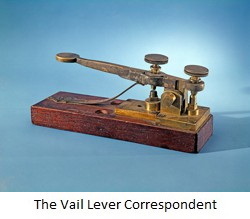 |
The first key made by Alfred Vail was a simple strap key; i.e. a piece of sheet metal mounted on a wooden base with a keying contact. His next key from the famous 1844 demonstration, called the Vail Lever Correspondent, might be familiar to people since it is on display at the Smithsonian Museum of American History. This key is more like the typical telegraph instrument in that it pivots on a metal shaft. |
 |
During the 1850's, many telegraph keys were based on a "camelback" design; that is, the lever had a pronounced hump in the middle. The earliest keys also lacked an integrated circuit closer switch. The key and the circuit closer were separate components mounted on the operator's desk. It wasn't until later in the 1850's that the circuit closer became part of the telegraph key itself. In addition, the early keys were "leg keys". Instead of binding posts on the key for which to attach wires, the key had 2 long legs protruding downward from the base which would fit into holes in the operators desk. The wires would then be attached to the legs. |
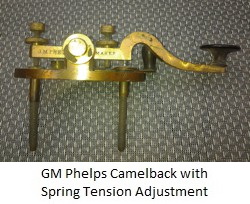 |
The next major improvement in telegraph key design occurred in the early 1860's when GM Phelps created the adjustable spring tensioner on the key. Prior to that, keys had a non-adjustable spring which may or may not have been optimal for the particular operator. |
By the mid 1860's, the camelback key design was starting to give way to the straight brass lever. Although some makers continued to use the camelback design, more were going with the straight lever. Many of the keys from the 1870's used this simple straight lever.
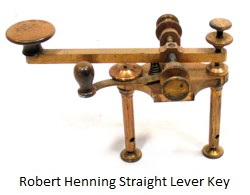 |
One design flaw with all of the brass lever keys is that with extended use of the key, over time the steel pivot pin would start to work itself loose in the softer brass lever, which could allow the lever to move sideways on the pin, which in turn caused the keying contacts to mis-align. Some makers added a set-screw on top of the lever to help secure the pivot pin. |
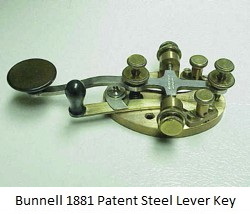 |
This problem was solved in 1881 when JH Bunnell invented the steel lever telegraph key. Instead of having a steel pivot pin press-fit into the brass lever, the lever and pivot pin were integrated into a single steel part. This completely eliminated the problem of the pin working itself loose. Steel lever keys of this design continue to be used today.
|
The 1880's saw some of the more unusual key designs appear as inventors came up with all sorts of novel ideas to improve the operation of the key. Many of these improvements were centered around changes to the contacts. Some keys like the Stevens Key & Biggs Key put the contacts at the rear of the key, while the Cumming Periphery Contact Key, Delany Key, and Prosch Key had contacts that could be rotated to a new position when the contacts became dirty. The Cumming Key actually used 2 circular disks with platinum wires around the periphery to accomplish the keying. Examples of these unusual keys can be seen in the US Landline Pages to the left.
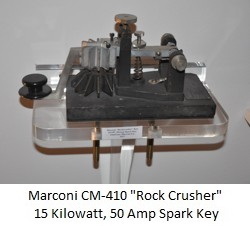 |
The turn of the 20th Century saw the birth of wireless communication. Telegraph key designs evolved to meet the needs of the new wireless systems. These systems operated at high voltages and currents, which meant the telegraph keys needed to be able to handle this high current. Hence, the early Wireless Keys, also called Spark Keys, had much larger keying contacts than landline keys. Some had contacts over 1/2" in diameter ! |
As wireless technology evolved and people learned about radio wave propagation, they also learned that it was not necessary to use very high power to communicate over long distances, so spark keys began to move back toward smaller contacts. By the WW2 era, radio technology had greatly matured and amateur radio began to take off after the war. Hams used whatever keys they could find to get on the air, from early landline to wireless keys, to bugs.
Click on the links to the left to see examples of Landline & Wireless keys as well as keys from all over the world.
Please note that due to the overwhelming number of keys produced in the 20th Century, these pages will, with some exceptions, only cover keys made up until approximately WW2.

Questions or comments?
You can reach me at telegraphdude@comcast.net






